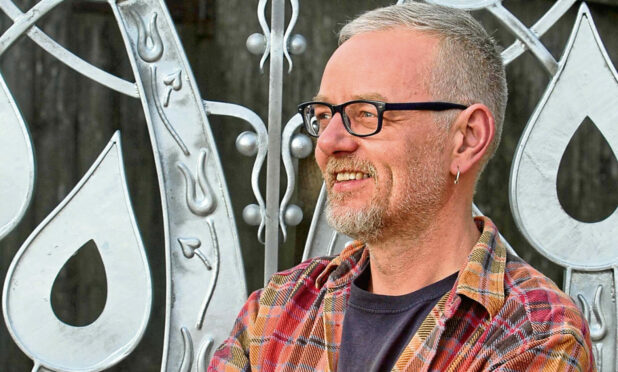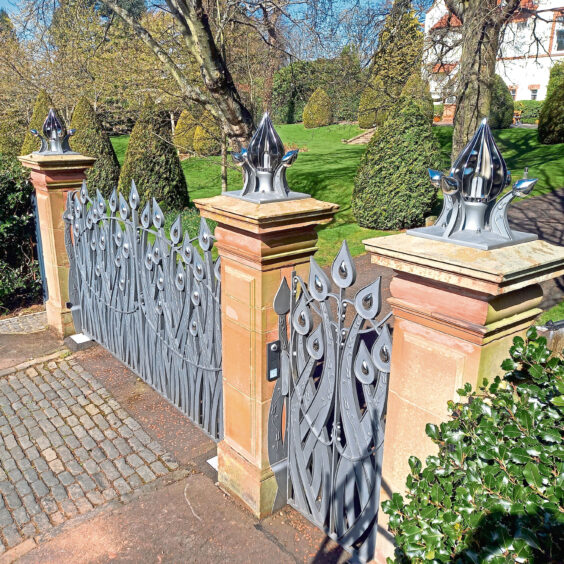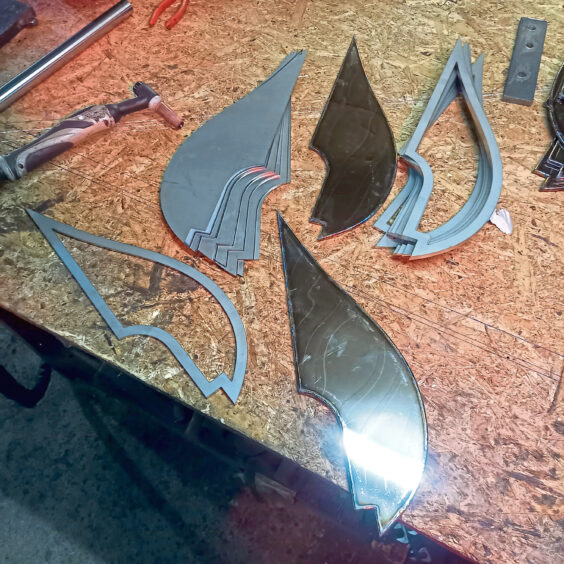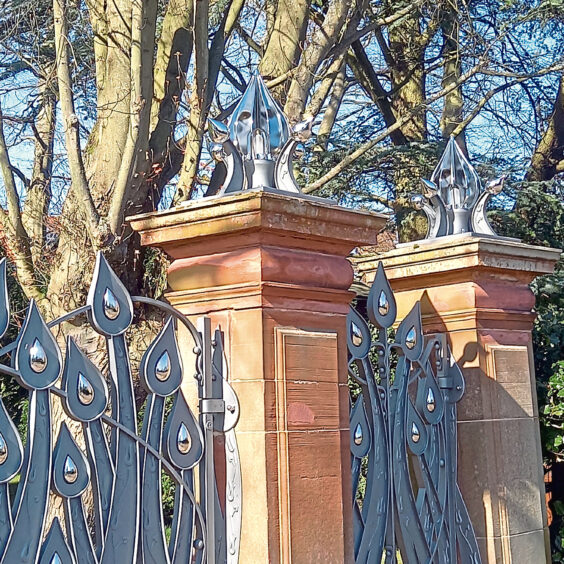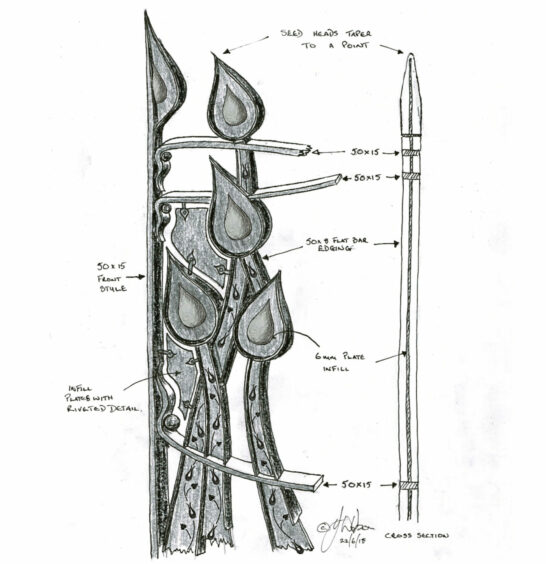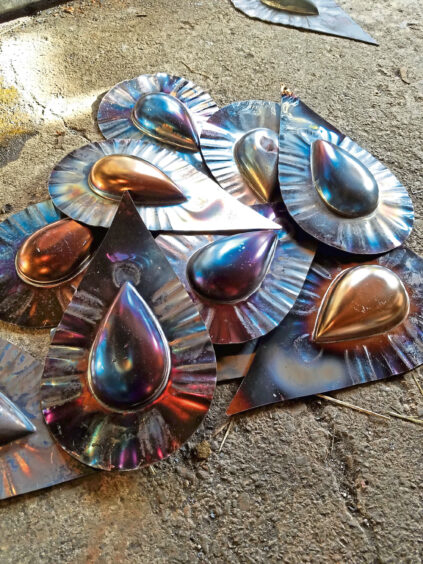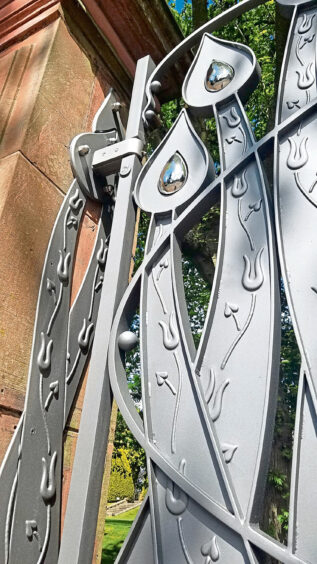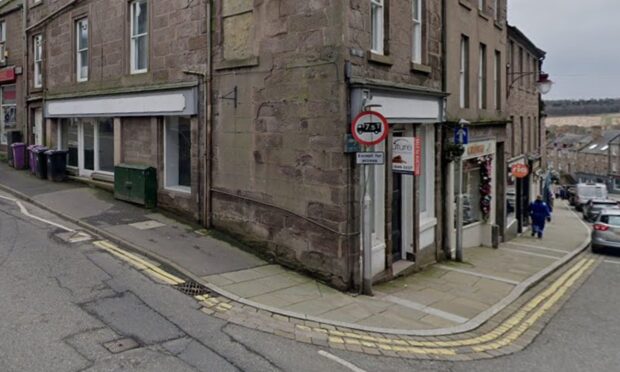Jim Whitson, aka the Blazing Blacksmith, has won a prestigious award for magnificent gates he created. Gayle Ritchie chats to the former Dundee High School pupil about his work.
Sparks fly when Jim Whitson gets to work.
Hammering away at red hot steel, fresh out of a roaring forge and heated to around 1,200C, it’s a sweaty, hazardous business.
Jim, aka the Blazing Blacksmith, works on a huge variety of commissions, from ornate railings and spiral staircases to gates, benches, sculptures, jewellery and even bannock toasters.
The former Dundee High School pupil is delighted that his craftmanship and creativity have been recognised by the Worshipful Company of Blacksmiths, an institution thought to have been around since 1299.
Borders-based Jim, 50, was announced as this year’s winner of the hotly contested Tonypandy Cup just last month.
He scooped the prize for magnificent decorative gates he made for a property in Edinburgh’s Barnton.
The dad of two is heading to London later this month where he’ll be presented with the award at a glittering ceremony. “I’m so delighted; I can’t quite believe it,” says Jim when we catch up over the phone.
“It’s even more special because it was judged by blacksmiths and not just a panel of people who like looking at nice things. It was judged on technical skill and design and was an in-depth process.”
Local lad
Jim, who grew up in the tiny hamlet of Logie Pert near Brechin, and is the son of Courier columnist Angus Whitson, originally studied 3D design at Cumbria College of Art and Design before training as a blacksmith.
He always imagined he wanted a career in woodwork – “I wanted to be a cabinet maker or a boat builder originally” – but he realised he much preferred metal.
“I started messing about with it when I was studying at art college,” he says. “It was easier to get the flowing shapes I wanted out of metal.”
He then served as an apprentice for blacksmith Mike Crummy for three years in Tomatin in the Highlands before moving to Edinburgh.
“I knew I wanted to do interesting stuff rather than bog standard fabrication,” he says. “I wanted to make things that meant something to people. I didn’t want them to order my products from a catalogue and say: ‘I’ll have gate number six please’.”
Intimate details
Clients have a great deal of input into the making process as many of the jobs Jim takes on include intimate details with a very personal element.
A great deal of time is spent on design and planning to ensure they get the pieces they desire.
Jim says when someone commissions a piece from him, it’s not just some “whimsical notion”.
“Many projects involve little details which mean something to people.
“I worked on some gates for a couple in Berwick-upon-Tweed and wanted to reflect their interests and passions in the design.
“She was a palaeontologist and liked gardening and he had been a marine engineer. They had travelled extensively during their working life so I included features in panels like a propeller, some tulips, an ammonite and a boat – things that meant a lot to them.”
Many projects involve little details which mean something to people.”
JIM WHITSON
Jim enjoys creating things that are particular to a site or a person. “I like having a personal link – a connection with the client. That’s what drives most of my work.”
The prize-winning Edinburgh gates, which feature tall-stemmed flowers, take inspiration from the Arts and Crafts movement, in keeping with detailing inside the house they guard.
“They were one of the biggest jobs and among the most complex designs I’ve done,” says Jim.
“The clients were fantastic. They gave me the freedom to create and put a great deal of trust in me.”
His latest commission, in Northumberland, is a big set of gates and railing with “hundreds of repeat components”.
For much of the last two months, Jim and his apprentices Lewis and Connor have been working solidly at the anvil making leaves and scrolls and shaping spindles.
“It’s hot, hard sweaty work with very little down time but finishing a pile of 460 leaves after more than three weeks’ solid work is a lovely feeling!” Jim says.
“We do have some sparks, lots of heat, quite a bit of dust and grime and a lot of noise.
“It’s lovely.”
Temperatures in Jim’s forge this summer were into the high 30s.
“It’s always the way that the heaviest forging jobs seem to come on the hottest days of the year!
“It’s so satisfying to take a straight piece of steel from a length on the steel rack and create something beautiful or practical or both.
“Steel is generally regarded as a strong and solid material but if you heat it to around 11-1200C it becomes a wonderful malleable medium that, for a short time, can be beaten and shaped into the most delicate of forms.
“Some machines have developed over the centuries but many of the techniques and skills are as they were 500 years ago.”
In terms of most unusual commissions over the years, Jim reckons his reproduction of a bannock toaster is up there with the finest.
“It’s on display in the Ellisland farm museum in South Ayrshire. It’s a replica of a bannock toaster given to Jean Armour on her marriage to Robert Burns. It’s a fairly odd looking thing.”
Other outlandish projects include a huge staircase with vines and oak trees growing up and out of it and a sculpture of a canoe on Dundee’s Riverside Drive.
“I created that for Jeremy Cunningham and Paul Grimes after they first produced a sketch maquette as part of a competition.”
The meeting with Jeremy was what led Jim to move from Gorebridge to Eddleston near Peebles in the Borders.
“The farm I had a workshop on was being sold and I was keen to move. Luck had it that Jeremy was selling his house and workshop in Eddleston, and that’s where I am now!”
Obviously hugely talented, what does Jim reckon is the recipe for success when it comes to blacksmithing?
“Being pedantic and getting things right in the workshop. I’m quite strict with my design process. I seldom do a job where I start off and just have a play. You need to be a good planner and to think about the process right down to the tiny details. My problem, or obsession, is latches and hinges. I like to make them as nice as possible. Latches are the main interaction people will really have with a gate so they need to be good!”
Future of blacksmithing?
When I ask if Jim considers blacksmithing to be a dying art, Jim is adamant that no, it is not.
“There are more blacksmiths starting up now than there have been for a long time,” he says.
“Loads of kids are going to college and doing degrees in blacksmithing. On paper they are better qualified than me!
“The difficulty for them is getting work or an apprenticeship afterwards. Getting on to the next step can be tricky. I get a lot of enquiries but taking someone on is a big commitment and there aren’t an awful lot of blacksmiths out there.”
What advice would Jim give to anyone wishing to follow in his footsteps?
“Go out and try it first. Even if you work alongside someone sweeping the floor for a few weeks, it’ll give you an insight into the industry and will be a chance to see whether you really like it. I’m a big fan of people trying things to get into the workplace.
“I had a lot of hands-on experience working with a sheet metal work company and general blacksmiths, and it was all really useful. It’s good if you know a bit about blacksmithing before you hit college so that at least you won’t be spending the first six months learning how to use a hammer.”
‘University isn’t the right path for everyone’
As a former Dundee High pupil, Jim was surprised to be asked to be featured in the next edition of the school’s magazine.
“I wasn’t the best pupil so to read about myself a few decades on will be a bit odd!” he laughs.
“Hopefully the current pupils can enjoy reading about me and maybe learn something! University and academia isn’t the right path for everyone.”
